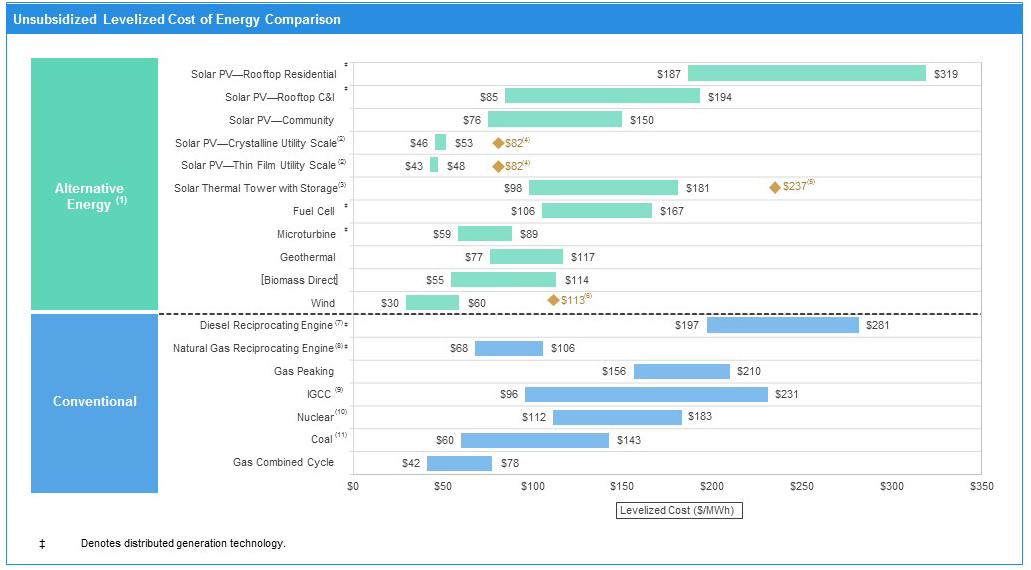Wind generation is one of the cheapest forms of new electricity generation. In New Zealand, wind farms do not receive subsidies. For this reason, developers will only build a wind farm if the wind farm can produce electricity at a cost that is competitive with other forms of generation and meets the commercial returns required by the developer.
A major benefit of wind energy is cost certainty. Once a wind farm has been constructed, the fuel for wind farms - the wind - is free. This means the future cost of wind energy will not be affected by increasing fossil fuel prices or the cost of greenhouse gas emissions. Wind farm owners need only consider ongoing operating and maintenance costs and increasingly it is possible to secure long term maintenance contracts if owners do not wish to undertake their own maintenance.
The average New Zealand retail cost of electricity is 29.2 cents per kilowatt hour (c/kwh) or 17.1c/kwh excluding lines charges. An energy cost of 17.1c/kwh equates to $171 per megawattt hour (MWh).
Estimates of the cost of wind-generated electricity vary. The reason for this wide range is that there are many variable factors that affect the cost of developing a wind farm - such as wind speeds, ability to maximise generation, construction costs, the cost of connecting the wind farm to transmission lines, capital costs, market conditions for wind turbines, the exchange rate and commodity prices.
The Ministry of Business Innovation and Employment in its latest Electricity Demand and Generation Scenarios Summary (August 2016) has estimated the long run marginal cost (LRMC) of wind energy at between $90 and $105 MWh. They also have a 10% lower cost model which has wind from $80+ MWh. Many in the industry now consider, with improvements in technology and the benefit of economies of scale from increased world-wide demand, wind farms can be built in New Zealand with a LRMC of $70 to $80 MWh.
International cost trends
The cost of electricity from wind turbines has decreased dramatically and further reductions in cost are forecast. Recent analysis by Lazard highlight the extent of the cost reduction (in US$).
Analysis by Lazard also highlight how cost competitive wind energy is with other forms of generation.
The Lawrence Berkley National Laboratory recently published the results of a global survey of 163 wind energy experts. The baseline cost for onshore wind is expected to decline by 25% from $79 MWh (2014 baseline) to $58.50 MWh by 2030 with a further decline to $50 MWh by 2050.
While offshore wind costs will remain significantly higher than for onshore cost, more substantial reductions in offshore wind costs are forecast, 30% by 2030 and 38% by 2050 to $100MWh.
Cost of integrating wind into the electricity system
There are costs associated with integrating increasing amounts of wind energy into the electricity system, but these costs are estimated to be less than the costs associated with continuing to rely on thermal generation. Given the increasing number of wind farms being developed internationally, NZWEA considers the cost could occur even in the short to medium term.
A study lead by Goran Strbac, A study lead by Goran Strbac, Professor of Electrical Energy Systems at Imperial College in the UK, and commissioned by Meridian Energy identified that the cost of integrating wind into the New Zealand electricity system is many times lower than experienced in Europe, primarily because of New Zealand's excellent wind resource and significant hydro generation. The Strbac study also noted that costs associated with greater use of wind in New Zealand included additional costs for system reserves (instantaneous, frequency-keeping and scheduling reserves) and generation capacity (as wind has limited ability to provide generation capacity at peak demand). For integrating 2000 MW of installed generating capacity by 2020, the additional cost would be between $2.06 and $2.76/MWh of wind energy - an amount significantly less than the effect of the cost of carbon on gas and coal generated electricity.


